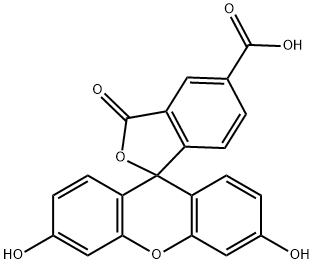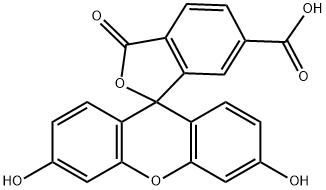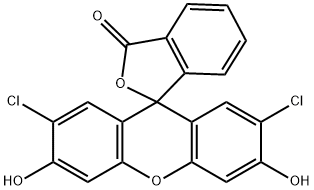5-Carboxyfluorescein , 95% , 76823-03-5
Synonym(s):
5-Carboxyfluorescein;5-FAM
CAS NO.:76823-03-5
Empirical Formula: C21H12O7
Molecular Weight: 376.32
MDL number: MFCD00036874
EINECS: 691-482-7
| Pack Size | Price | Stock | Quantity |
| 25MG | RMB72.80 | In Stock |
|
| 100MG | RMB148.00 | In Stock |
|
| 250mg | RMB284.80 | In Stock |
|
| 500MG | RMB364.80 | In Stock |
|
| 1G | RMB657.60 | In Stock |
|
| 5G | RMB2374.40 | In Stock |
|
| others | Enquire |
PRODUCT Properties
| Melting point: | 368-372°C |
| Boiling point: | 725.2±60.0 °C(Predicted) |
| Density | 1.73±0.1 g/cm3(Predicted) |
| storage temp. | Keep in dark place,Sealed in dry,2-8°C |
| solubility | DMF: soluble |
| form | Solid |
| pka | 3.3, 4.6, 6.4, 7.0(at 25℃) |
| color | Yellow to orange |
| PH Range | Weak green ' uorescence (6.0) to strong green ' uourescence (7.2) |
| λmax | 492nm |
| BRN | 57037 |
| Biological Applications | Authenticating canned products; detecting/measuring citrate; as a substrate for measuring phospholipase activity; use in ophthalmology |
| Major Application | Fluorescent probe, diagnosis of cancer, leukemia, colorectal cancer, polynucleotide, bacteria, pathogens, nucleic acid, hepatitis A virus, dengue virus, herpes simplex virus, gene, HIV type, cardiovascular risk factor |
| InChIKey | NJYVEMPWNAYQQN-UHFFFAOYSA-N |
| CAS DataBase Reference | 76823-03-5(CAS DataBase Reference) |
Description and Uses
5-Carboxyfluorescein is a single isomer derivative of 5(6)-carboxyfluorescein that can be used to fluorescently label biomolecules through the interaction of carboxylic acid with primary amines. It demonstrates excitation/emission maxima of 492 and 518 nm, respectively.
5-Carboxyfluorescein(5-FAM) contains a carboxylic acid that can be used to react with primary amines via carbodiimide activation of the carboxylic acid. It is a useful reagent for the preparation of hydrolytically stable fluorescent conjugates and is a useful starting material for the synthesis of other fluorescein-derives reagent. It has been principally used to develop a variety of green fluorescent reagents and small fluorescent molecules due to its relatively high absorbance characteristics, excellent fluorescence quantum yield, and good water solubility. The probe has also found application in studies of liposome-cell, cell-cell, and liposome-liposome interactions and in related studies on lipid bilayer structures.






